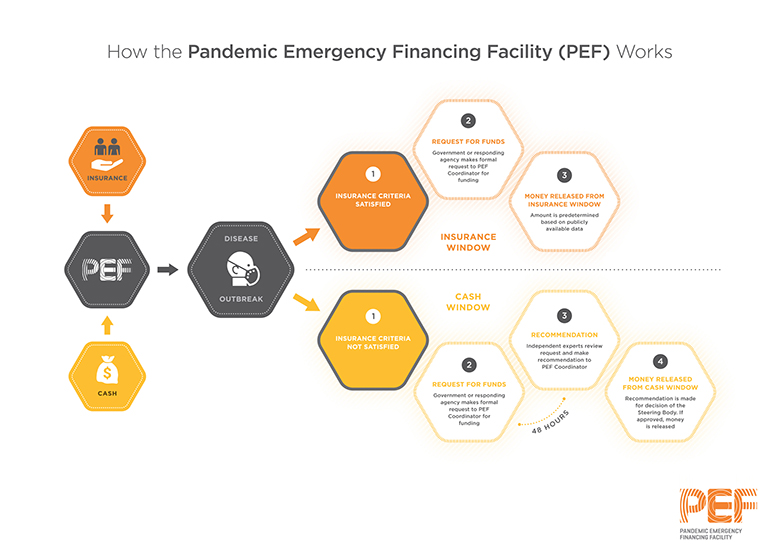The Pandemic Emergency Financing Facility officially closed on April 30, 2021.

What is the Pandemic Emergency Financing Facility (PEF) and why is it needed?
- The Pandemic Emergency Financing Facility (PEF) – a financing mechanism housed at the World Bank – is designed to provide an additional source of financing to help the world’s poorest countries respond to cross-border, large-scale outbreaks.
- Launched in July 2017, the PEF is based on the experience of the devastating, cross-border 2014-15 West Africa Ebola outbreak, which claimed more than 11,000 lives. At the time, the world lacked the appropriate financial mechanisms to drive resources for outbreaks that were quickly escalating.
- It was developed by a global team of experts in epidemiology, public health and finance so that countries could get the support they need to fight deadly, cross-border pandemics.
- The PEF complements the much larger role that IDA, the World Bank’s fund for the poorest countries, and other international organizations and donors play in financing outbreak response.
Who is covered under the PEF, for what, and how much funding has it provided so far?
- The PEF is designed to provide an additional source of financing to help the world’s poorest countries respond to outbreaks.
· The PEF provides financing through two windows: a cash window and an insurance window. The insurance and cash windows are triggered in very different ways and are specifically designed to complement each other. To date, the PEF has paid out US$61.4 million from its cash window to fight Ebola in DRC, including $50 million for the current 10th outbreak.
- The insurance window provides coverage of up to $425 million to all IDA-eligible countries for diseases that are listed by WHO as likely to cause major epidemics if contagion spreads across national borders. These include new pandemic influenza, SARS, MERS, Ebola, Marburg and Crimean Congo hemorrhagic fever, Rift Valley fever, and Lassa fever.
What is the cash window of the PEF and how does it work?
- The cash window is triggered by expert advice based on the pathogen type and epidemiological thresholds with a final decision by the PEF steering body which oversees PEF operations.
- Funds from the cash window can be transferred within days of approval by the steering body which is composed of donors, international organizations (including the WHO, UNICEF, and the World Bank), and two IDA-eligible countries (Liberia and Haiti). WHO and the World Bank serve as non-voting members.
- PEF grants can go directly to governments and to qualified responding agencies, such as WHO and UNICEF.
- The PEF cash window has been triggered three times, for the 9th and 10th Ebola outbreaks in the DRC providing $61.4 million to fight the outbreaks ($11.4m in 2018 for the 9th outbreak and $50m in 2019 for the 10th outbreak).
What is the insurance window of the PEF and how does it work?
- The insurance window is triggered once the parametric triggers, such as outbreak size, growth rate and spread across borders, are met.
- The PEF’s insurance window works like any other insurance: it pays a premium to buy protection against a worst-case scenario of a cross-border pandemic.
- The insurance window has purchased $425 million aggregate insurance at an annualized premium cost of $36.2 million (or equivalent to 8.5%).
- The payment for bond coupons is covered in part by the PEF and in part by the World Bank. The portion paid by PEF is funded by the donor governments.
- Dividing the annual cost of the insurance by the population of the countries it covers, PEF insurance costs 2.1 cents per person per year.
What is the governance structure of the PEF?
- Operations of the PEF are overseen by a steering body composed of donors (Japan, Germany, and Australia), international organizations (including the World Health Organization, UNICEF, and the World Bank), and two IDA-eligible countries (Liberia and Haiti). Voting members of the steering body include Japan and Germany; WHO and the World Bank serve as non-voting members.
- The PEF Coordinator actively monitors disease outbreaks and is in constant communication with affected countries and international responding agencies, such as the WHO and UNICEF.
- So far, health events that the PEF Coordinator's office has monitored include the Marburg virus in Uganda, plague in Madagascar, and two Ebola outbreaks in DRC.
- Event Eligibility Notices were issued in the case of the 2018 Lassa fever outbreak in Nigeria and the 10th Ebola outbreak in DRC. These notices initiate formal monitoring of an outbreak to determine potential eligibility of payment from the insurance window.
Is the PEF the only crisis support instrument of the World Bank Group?
- The PEF complements the much larger role that IDA, the World Bank’s fund for the poorest countries, and other international organizations and donors play in financing outbreak response.
- The PEF is one element of the World Bank Group’s Global Crisis Management Platform, which brings together a range of crisis support instruments to IDA-eligible countries that face an outbreak.
- Overall, the World Bank, has committed $350 million from IDA in response to the 10th outbreak of Ebola in DRC (plus the additional US$50 million disbursed from the PEF). The funds enable responders to step up the frontline health response, deliver cash-for-work programs to support the local economy, strengthen resilience in the affected communities, and contain the spread of this deadly virus.
Last Updated: Sep 23, 2021